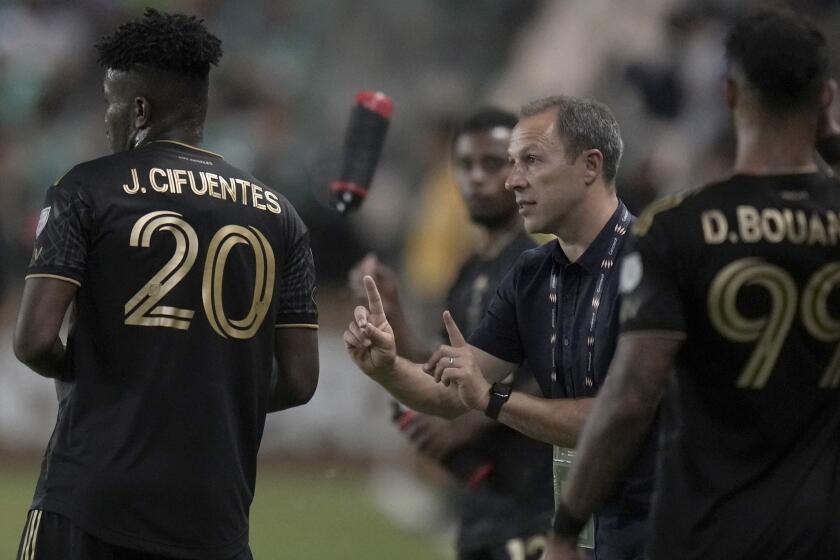Fans Still in Love With John Henry
- Share via
LEXINGTON, Ky. — Close encounters with our heroes are often disappointing. They are shorter or fatter than we’ve imagined, or rude or poor spoken, or perhaps worst of all, just ordinary.
And so it seems, at first, with John Henry.
The small, dark brown thoroughbred standing bridled in the ring with a dungareed groom outside the Hall of Champions at the Kentucky Horse Park doesn’t look that much different from the horses that earn their keep by carting visitors around the sprawling state-owned facility dedicated to “man’s relationship with the horse.”
The crowd of 30 perched on bleachers six feet away stare intently at John Henry, trying to see the intangible that distinguished him from thousands of others on the race track.
“John Henry won seven Eclipse Awards--he earned more than $6 million dollars--more than another other American race horse,” park employee Matt Jaeger tells the crowd. “He came here last year after he got hurt training. He probably could have come back and raced and won again, but his owners wisely decided he had given them more than enough over the years and they sent him here to enjoy the rest of his life.”
John Henry was 10 when he retired--more than twice the age of most of the competitors he beat so handily, particularly on grass courses.
“He is probably the most famous horse of all time. You walk up to somebody in the street and ask him who Forego was and he probably won’t know,” Jaeger continues, “but say John Henry, and he’ll know right away. . . .
“The people loved John Henry so much that once, when he got beat and finished second, the crowd booed the winner and cheered John Henry. And when John Henry came off the track, he went right to the winner’s circle, anyway.”
The people laugh appreciatively, and they notice the determined way John Henry is tossing his head, trying to pull the lead of his bridle out of the hands of groom Donnie Moore.
They applaud as Moore leads John Henry back to his spacious stall, and the horse’s ears prick up at the familiar sound. He twists his head back over his shoulder to stare at the fans--or perhaps to make sure they are still watching--as he enters the barn.
A couple minutes later, Moore opens John Henry’s back door, and the gelding walks into his paddock. He stands near the white picket fence a couple moments, as if counting the house. Then, apparently satisfied with the turnout, he begins to run.
He runs easily at first along the fence, getting the kinks of out of his 11-year-old legs. And then, suddenly, he turns up the speed, cuts a sharp turn and heads to center stage, where he bucks and jumps like a colt.
The sight of John Henry airborne, all four legs off the ground, rump pointed upward, head tossed back, is breathtaking.
Those who witness it know they will never forget it.
This is one hero who survives one-on-one encounters with his fans with his image intact.
“I always wondered, watching the jockeys driving horses down the track if the horses really liked to run,” a spectator comments. “Now I know that at least this one does.”
More to Read
Go beyond the scoreboard
Get the latest on L.A.'s teams in the daily Sports Report newsletter.
You may occasionally receive promotional content from the Los Angeles Times.










